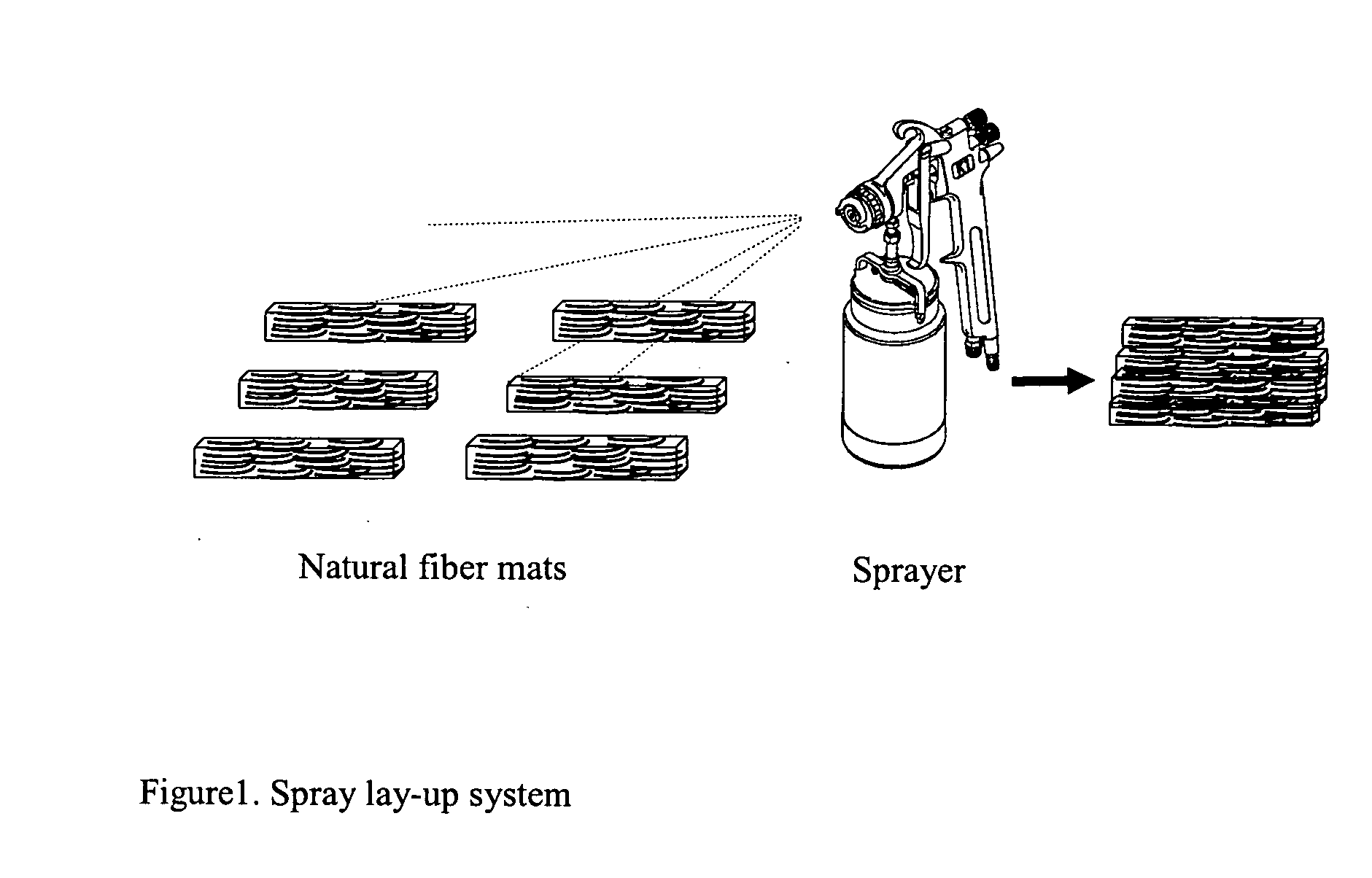Thermo durable and high performance natural fiber molded composites manufacturing process
a manufacturing process and natural fiber technology, applied in the field of thermo durable and high-performance natural fiber molded composite manufacturing process, can solve the problem of further prone to polymerization of precursors
- Summary
- Abstract
- Description
- Claims
- Application Information
AI Technical Summary
Benefits of technology
Problems solved by technology
Method used
Image
Examples
example 1
Processing of a Moldable Non-Woven Cellulosic Thermoset Mat by Vacuum Impregnation
[0034] Bast fibers, prefereably non-woven hemp with an average length of 2.5 centimeter and 9 centimeter were selected and 28 grams of fibers randomly oriented in a Buckner funnel with the inner diameter of 19 cm which connected to a vacuum system. A resin solution with 10 weight percentage of resin prepared by adding water as a solvent to an environmentally friendly acrylic resin to circulate through the fibers. The resin solution was circulated for 5 minutes to impregnate all the fibers with the solution. In the last stage, 2 minutes vacuum filtration was applied to remove the excess solution and keep almost 185 gram of the resin solution inside the fibers to have a composite with 40% resin content. After circulation of the resin solution, the wet mat was removed from Buckner and placed on the polyester sheet and then kept in the oven at 55° C. for 36 hrs to remove all moisture content. The mat woul...
example 2
Compression Processing of a Moldable Non-Woven Cellulosic Resin Impregnated Mat Under Various Processing Condition
The vacuum resin impregnation processing of the non-woven cellulosic mats are the same as mentioned in example 1.
[0035] In one case, the moldable non-woven cellulosic resin impregnated mats were molded at different temperatures of 175, 180, 185 degree centigrade for 12 minutes
[0036] In the other case, the moldable non-woven cellulosic resin impregnated mats were molded at the temperature of 180 degree centigrade for two different times 10 and 12 minutes.
[0037] In the other case, the moldable non-woven cellulosic resin impregnated mat were manufactured for two different fiber lengths 2.5 and 9 centimeter and molded at the temperature of 180 degree centigrade for 10 minutes.
example 3
Compression Processing a Moldable Non-Woven Cellulosic Resin Impregnated Mat Using a Prototype Mold
The vacuum resin impregnation processing of the non-woven cellulosic mats are the same as mentioned in example 1.
[0038] Having acceptable mechanical properties, a prototype mold was designed and built for an exterior mirror frame of automobile. The stainless steel mold contains two male and female parts was installed onto the platens of the hydraulic press. A moldable non-woven cellulosic resin impregnated mat obtained from example 1 was molded using the above mentioned mold at the temperature of 180 degree centigrade for 10 minutes under the pressure of 30 tones. Curvatures of the specimen clearly show a good formability of the composite especially at the corners.
PUM
| Property | Measurement | Unit |
|---|---|---|
| Length | aaaaa | aaaaa |
| Length | aaaaa | aaaaa |
| Fraction | aaaaa | aaaaa |
Abstract
Description
Claims
Application Information
 Login to View More
Login to View More - R&D
- Intellectual Property
- Life Sciences
- Materials
- Tech Scout
- Unparalleled Data Quality
- Higher Quality Content
- 60% Fewer Hallucinations
Browse by: Latest US Patents, China's latest patents, Technical Efficacy Thesaurus, Application Domain, Technology Topic, Popular Technical Reports.
© 2025 PatSnap. All rights reserved.Legal|Privacy policy|Modern Slavery Act Transparency Statement|Sitemap|About US| Contact US: help@patsnap.com



